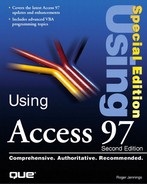Creating Scalable Access Applications
Regardless of the linguistic legitimacy of terms such as rightsizing, these words have become ingrained in today's computerese. Each of these expressions relates to the scalability of applications. Scalable applications can run on a variety of platforms, communicate by industry-standard LAN and wide area networking (WAN) protocols, and access data stored in a variety of different types of databases. 32-bit Access 97 runs under Windows 95 or Windows NT 3.51+, so Access itself is moderately scalable. Access 97 is a threaded application and Jet 3.5 is multithreaded; thus, Access can take advantage of the symmetrical multiprocessing (SMP) capabilities of Windows NT running on workstations with multiple processors. Windows NT runs on Intel-based PCs and RISC systems, such as DEC Alpha servers and IBM PowerPC platforms, but you need a version of Access 97 that's compiled for the specific RISC processor in use. It remains to be seen whether Microsoft intends to release versions of Office 97 for use with Windows NT running on RISC machines.
On the networking front, Windows 95 and Windows NT support the three most common networking protocols: NetBEUI, IPX/SPX, and TCP/IP. Following is a brief description of each of these protocols:
NetBEUI (NetBIOS Extended User Interface) is the foundation of Windows Networking and the simplest LAN protocol to implement. NetBEUI isn't a routable protocol, so it isn't suitable for large-scale networks. NetBEUI, however, is quite efficient and useful for setting up LANs in small- to medium-sized organizations.
IPX/SPX (Internetwork Packet Exchange/Sequenced Packet Exchange) is the primary protocol for Novell NetWare LANs. IPX/SPX is the default network protocol for Windows 95 because of the large installed base of NetWare 3.x/4.x LANs.
TCP/IP (Tranmission Control Protocol/Internet Protocol) is the protocol of the Internet and UNIX systems. TCP/IP is a routable protocol that enables the creation of very large LANs and WANs. The remarkable growth of the Internet in the mid-1990s has established TCP/IP as the standard protocol for scalable networking.
Fortunately, Windows 95 and Windows NT 3.5+ let you run all three of these protocols simultaneously. Unless you're connected to a NetWare LAN, it's more efficient to use only NetBEUI and TCP/IP. As an example, you might connect to SQL Server 6.5 running under Windows NT Server 4.0 with NetBEUI and to Sybase System 11 or Oracle7 running on a UNIX server with TCP/IP.
The third element of scalability, the capability to access data that resides in a variety of SQL-compliant databases, is provided by Microsoft's Open Database Connectivity (ODBC) products. Office 97 includes the new 32-bit ODBC 3.0 Administrator application and a 32-bit ODBC driver for Microsoft SQL Server. There are about 150 third-party suppliers of ODBC drivers. ODBC provides Access with the capability to connect virtually to any popular mainframe-,minicomputer-, RISC-, and PC-resident SQL-compliant database through Microsoft and third-party 32-bit ODBC drivers. This chapter describes how ODBC works and how you can connect to client/server databases with ODBC drivers.
Note
Access 97 requires 32-bit ODBC drivers to connect to client/server RDBMSs. Existing 16-bit ODBC 2.0 drivers used with Access 2.0 and its predecessors do not work with Access 97. If you are upgrading from Access 2.0 (or an earlier version), and are using 16-bit ODBC drivers for RDBMSs other than Microsoft SQL Server, you must obtain 32-bit versions of ODBC drivers from the RDBMS vendor or a third-party publisher.
